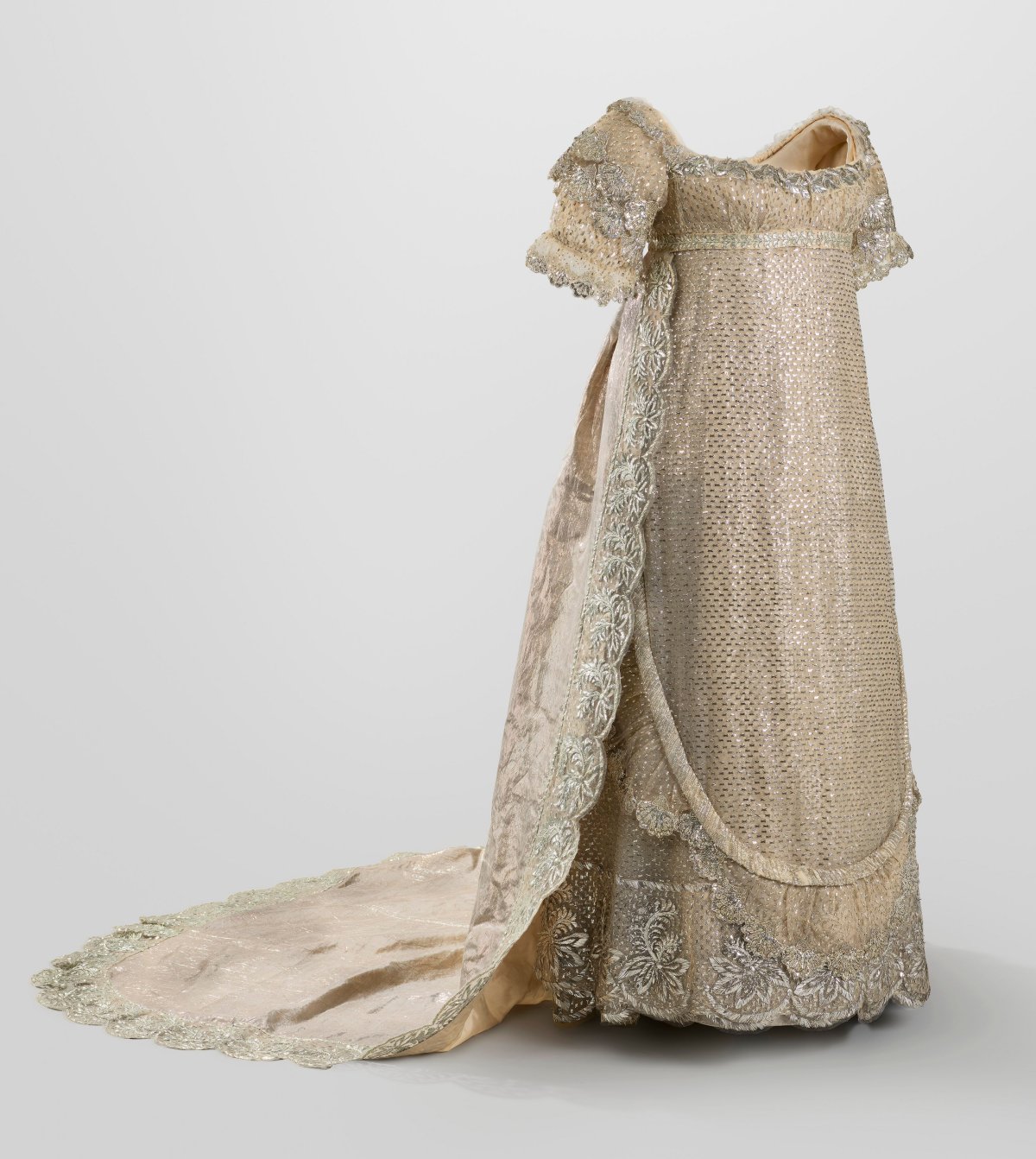
Last week, we previewed some of the gorgeous royal jewels currently on display at the Queen’s Gallery inside Buckingham Palace. Today, we’ve got a closer look at another fabulous artifact from the Georgian exhibition: the wedding gown worn by Princess Charlotte of Wales, daughter of King George IV.

For the first time in more than a decade, the Royal Collection is displaying the delicate, lovely wedding dress worn by Princess Charlotte of Wales for her wedding to Prince Leopold of Saxe-Coburg and Gotha in 1816. The Royal Collection shares that the marriage of Charlotte, who was presumed to be the future queen regnant, and Leopold was “considered one of the most important royal weddings of the era.”
Princess Charlotte had settled on Prince Leopold as an acceptable spouse after breaking her engagement with the Prince of Orange (later King Willem II of the Netherlands). The negotiations over Charlotte’s marriage—and indeed basically every part of the young princess’s life—were wrapped up in a power struggle between her warring parents, the Prince Regent and his estranged wife, Caroline of Brunswick.

Charlotte’s “silk embroidered bridal gown is the only royal wedding dress that survives from the Georgian period, though it appears to have been significantly altered from its original form, in keeping with the Georgian practice of repurposing and recycling clothing,” the Royal Collection explains. “The Princess followed the tradition for European royal brides to wear silver, despite white wedding dresses becoming popular by the end of the 18th century.” The gown was made for Charlotte by Mrs. Triaud, a London-based dressmaker with an atelier in Bolton Street.

The Collection elaborates, “This ensemble is a rare survival and is now very frail,” adding, “Usually, Charlotte preferred to dress more simply. Although associated with Princess Charlotte, the skirts and train may not be original to the ensemble.”

The marriage took place on the evening of May 2, 1816, at Carlton House, the London home of Charlotte’s father, the Prince Regent. The Morning Chronicle wrote that Charlotte glittered during the ceremony, which was conducted in the Crimson Drawing Room by the Archbishop of Canterbury. The paper’s correspondent reported that Charlotte’s “manteau of rich silver tissue lined with white satin, trimmed round with a most superb silver lama border, in shells to correspond with the dress” was “fastened in front with a most brilliant and costly ornament of diamonds.”

The headdress she wore with the gown was “a wreath of rose buds and leaves, composed of the most superb brilliants.” The Caledonian Mercury shared that her jewelry on her wedding day also included “a necklace of a single row of large brilliants, of the finest lustre, with large drop ear-rings to correspond, and a brilliant cestus of great value.” (A cestus is a belt or girdle, part of the neoclassical revival of the era’s popular fashion.) Overall, the Morning Chronicle reporter enthused, “The whole dress surpassed all conception in the brilliancy and richness of its effects.” It should have. The dress may have cost as much as £10,000, an enormous sum for the era.

Charlotte’s wedding trousseau also included a grand collection of jewels. Numerous newspapers reported that the jewelry included “a pearl necklace, and bracelets, with diamond clasps, equally splendid,” as well as “other ornaments, consisting of coloured stones, richly encircled with jewels.” Her wedding gift from her new husband was “a rich diamond armlet.”

Sadly, Charlotte did not have long left to enjoy her new marriage or her trousseau. She was only 21 when she died on November 6, 1817, after giving birth to a stillborn son. Her death rocked the royal family. Their grief was mixed with feelings of urgency over the suddenly insecure line of succession. Two of Charlotte’s uncles, the Duke of Clarence and the Duke of Kent, cast off their mistresses and raced to marry and produce heirs. The Duke of Clarence won in the short term, succeeding his brother as King William IV in 1831, but the Duke of Kent won the long game. The daughter produced by his marriage (to Prince Leopold’s sister, Princess Victoire) became Queen Victoria.

And what about the widowed Prince Leopold? After the death of his wife and son, Leopold was heartbroken. He stayed on at Claremont House in England, where his father-in-law granted him the style of His Royal Highness and his sister joined the royal family as the new Duchess of Kent. He became particularly fond of his niece, Queen Victoria.
But in the 1830s, everything changed for the prince. After turning down an offer to become King of Greece, he accepted the throne of Belgium when it was offered to him in 1831. The new King Leopold I of the Belgians moved to Brussels, where he began searching for a second wife. He was (reluctantly) accepted by Princess Louise-Marie of Orléans, a daughter of King Louis-Philippe of France. They had four children, including a daughter named Charlotte. (Sadly, her story was just as tragic as that of her namesake.)

Today, Princess Charlotte’s wedding dress is the oldest surviving example of a royal wedding dress in the Royal Collection. Visitors to London have the rare chance to see it in person this summer, as it’s part of the current exhibition, Style & Society: Dressing the Georgians, at the Queen’s Gallery, Buckingham Palace.

Tickets for the exhibition are currently on sale. You can read more about the exhibition itself here, and see some of the remarkable royal jewels on display in our earlier article.
Leave a Reply
You must be logged in to post a comment.